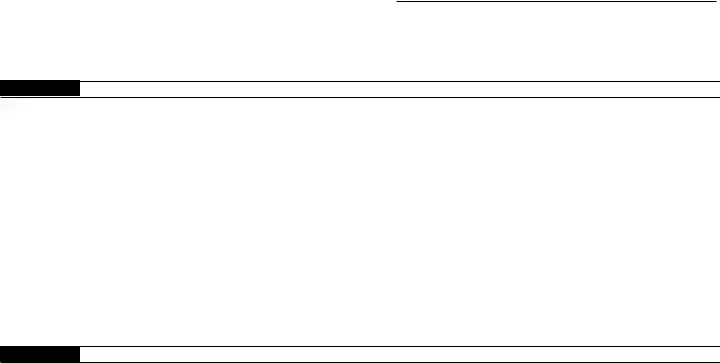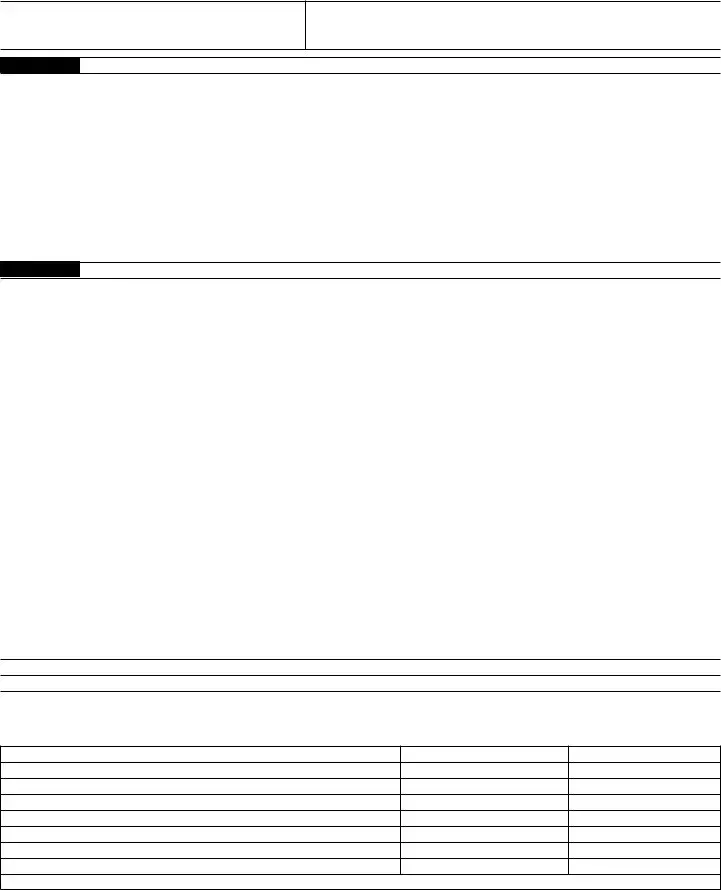SCHEDULE GE |
STATE OF HAWAII — DEPARTMENT OF TAXATION |
(FORM G-45/G-49) |
GENERAL EXCISE/USE TAX |
(REV. 2013) |
SCHEDULE OF EXEMPTIONS AND DEDUCTIONS |
|
|
(ATTACH THIS SCHEDULE TO FORMS G-45 AND G-49) |
|
FOR PERIOD ENDING __ __ / __ __ (MM/YY) OR TAX YEAR ENDING __ __ / __ __ / __ __ (MM/DD/YY) |
(NOTE ALL SECTION REFERENCES ARE TO THE HAWAII REVISED STATUTES UNLESS OTHERWISE NOTED)
HAWAII TAX I.D. NO. W __ __ __ __ __ __ __ __ — __ __ |
NAME: |
If you are claiming exemptions/deductions on your periodic and annual general excise/use tax return (Forms G-45 and G-49), complete and attach this form to your tax return. If you do not attach this form to your Forms G-45 and G-49, then your exemptions/deductions will be disallowed and additional taxes assessed. For more information on the exemptions/deductions, see the schedules of exemptions and deductions found in the General Instructions for Filing the General Excise/Use Tax Returns. Note: Most ordinary business expenses are NOT DEDUCTIBLE (e.g. materials, supplies, etc.) on your general excise/use tax return.
SECTION I GENERAL EXCISE/USE TAX EXEMPTIONS/DEDUCTIONS CLAIMED IN PART I, COLUMN B, OF FORMS G-45 AND G-49
(General Excise and Use Taxes @ 1/2 of 1 % (.005)) Check the box of the applicable General Excise/Use tax exemptions/deductions you are claiming on Forms G-45 and G-49. Enter the applicable amount claimed for each box checked. If more space is needed, attach a statement attach a statement which includes the Hawaii Revised Statutes section and amount claimed for each section.
|
|
|
|
|
|
|
|
|
Air Pollution Control Facilities |
|
Out of State Services or Contracting to |
|
|
|
|
(§§237-27.5, 238-3(k)) |
$ __________________ |
Foreign Customers (§238-2.3(1)(C)) |
|
$ |
__________________ |
Bad Debts (§237-3(b)) |
$ __________________ |
Petroleum Refining (§237-27) |
|
$ |
__________________ |
Disability Provisions (§237-24(13)) |
$ __________________ |
Producers (Certain property used) (§238-4) |
|
$ |
__________________ |
Discounts and Returned |
|
Taxes Passed On (§§237-24(8), 237-24(9), |
|
Merchandise (§237-3(b)) |
$ __________________ |
237-24(10), 237-24(12)) (CAUTION, SEE |
|
|
|
|
Enterprise Zones (§209E-11) |
$ __________________ |
FORMS G-45/G-49 INSTRUCTIONS.) |
|
$ |
__________________ |
Exported Services (§237-29.53) |
$ __________________ |
Wholesale Transactions (Sales of tangible property |
$ |
|
*Federally Preempted Amounts |
|
imported for further resale at 1/2%) (§237-29.55) ... |
______________________ |
|
Other: |
|
|
|
|
|
(§§237-22, 238-3(a)) |
$ __________________ |
|
|
|
|
|
Out of State Sales (§237-29.5(1)) |
$ __________________ |
HRS § |
|
|
|
$ |
__________________ |
|
|
|
1. SECTION I TOTAL - Add the amounts from Section I. Enter the result here and on line 5 in Section V |
$ |
__________________ |
SECTION II GENERAL EXCISE/USE TAX EXEMPTIONS/DEDUCTIONS CLAIMED IN PART II, COLUMN B, OF FORMS G-45 AND G-49 (Continued on page 2)
(General Excise and Use Taxes @ 4 % (.04)) Check the box of the applicable General Excise/Use tax exemptions/deductions you are claiming on Forms G-45 and G-49. Enter the applicable amount claimed for each box checked. If more space is needed, attach a statement which includes the Hawaii Revised Statutes section and amount claimed for each section.
|
Affordable Housing (§§46-15.1, 201H-36 |
|
Hawaii Convention Center Operator |
|
|
|
237-29, 238-3(j)) |
$ __________________ |
(§237-24.75(2)) |
$ |
__________________ |
|
|
|
|
Air Pollution Control Facilities (§§237-27.5, 238-3(k)) ... |
$ ______________________ |
Hotel Operator/Suboperator (§237-24.7(1)) |
$ |
______________________ |
|
Aircraft Leasing (§§237-24.3(11), 238-1)... |
$ __________________ |
Insurance Proceeds Received Because |
|
|
|
Aircraft Service and Maintenance Facility |
|
of a Natural Disaster (§237-24.7(6)) |
$ |
__________________ |
|
(§§237-24.9, 238-1) |
$ __________________ |
Intercompany Charges (§237-23.5(a)) |
$ |
__________________ |
|
Bad Debts (§237-3(b)) |
$ __________________ |
Labor Organizations (§237-24.3(9)) |
$ |
__________________ |
|
Certain Convention, Conference and |
|
Leases and Subleases of Real Property |
|
|
|
Trade Show (§237-16.8) |
$ __________________ |
(§237-16.5) |
$ |
__________________ |
|
|
|
|
Common Paymaster Exemption (§237-23.5(b)) |
$ ______________________ |
Maintenance Fees (§§237-24.3(2), 237-24(16)) |
$ |
______________________ |
|
Contracting Activity in an Enterprise Zone (§209E-11).. |
$ ______________________ |
Mass Transit (§237-24.7(2)) |
$ |
__________________ |
|
Diplomats and Consular Officials |
|
Merchants’ Association Dues (§237-24.3(8)) |
$ |
______________________ |
|
(§§237-24.3(10), 238-1) |
$ __________________ |
Non-profit Organizations (§237-23) |
$ |
__________________ |
|
Discounts and Returned Merchandise (§237-3(b)) |
$ ______________________ |
|
Orchard Operator (§237-24.7(4)) |
$ |
__________________ |
|
Drugs and Prosthetic Devices (§237-24.3(6)) |
$ __________________ |
|
Out of State Sales (§237-29.5(1)) |
$ |
__________________ |
|
Employee Benefit Plans (§237-24.3(4)) |
$ __________________ |
|
Potable Water (§237-23(a)(7)) |
$ |
__________________ |
|
Enterprise Zones (§209E-11) |
$ __________________ |
|
Professional Employer Organizations |
|
|
|
Exported Services (§237-29.53) |
$ __________________ |
|
|
|
(§237-24.75(3)) |
$ |
__________________ |
|
Federal Cost-Plus Contractors (§237-13(3)(C)) |
$ ______________________ |
Producers (Certain property used (§238-4)) |
$ |
__________________ |
|
*Federally Preempted Amounts |
|
Real Estate Sales (§237-3(b)) |
$ |
__________________ |
|
(§§237-22, 238-3(a)) |
$ __________________ |
Reimbursement of Payroll Costs (§237-24.7(9)) .....$ |
______________________ |
|
Food Stamps and WIC (§237-24.3(5)) |
$ __________________ |
|
Sales to Federal Government and |
|
|
|
Foreign Trade Zone Sales (§212-8) |
$ __________________ |
|
|
|
Credit Unions (§237-25(a)) |
$ |
__________________ |
|
|
|
|
|
*Additional information is required to claim these exemptions, complete Sections VI and VII on page 2. |
|
SCHEDULE GE |
|
|
(Continued on back) |
|
|
(FORM G-45/G-49) |
SCHEDULE GE (FORM G-45/G-49) (REV. 2013)
Name
PAGE 2
Hawaii Tax I.D. Number |
Period Ending (MM/YY) or |
|
Tax Year Ending (MM/DD/YY) |
|
|
SECTION II GENERAL EXCISE/USE TAX EXEMPTIONS/DEDUCTIONS CLAIMED IN PART II, COLUMN B, OF FORMS G-45 AND G-49 (Continued from page 1)
|
Scientific Contracts (§§237-26, 238-3(j)) ... |
$ __________________ |
*Subcontract Deduction (§237-13(3)(B))... |
$ |
__________________ |
|
Services Related to Ships and Aircraft |
|
Sugar Cane Payments to Independent |
|
|
|
|
(§237-24.3(3)) |
$ __________________ |
Producers (§237-24(14)) |
$ |
__________________ |
|
Shipbuilding and Ship Repairs (§237-28.1) .. |
$ __________________ |
Taxes Passed On (§§237-24(8), 237-24(9), |
|
|
|
|
Shipping and Handling of Agricultural |
|
237-24(10), 237-24(11), 237-24(12), 237-24.3(7), |
|
|
|
|
237-24.7(3)) (CAUTION, SEE FORMS G-45/G-49 INSTR.) $ |
______________________ |
|
Commodities (§237-24.3(1)) |
$ __________________ |
|
|
|
|
|
|
|
|
Small Business Innovation Research |
|
TRICARE (§237-24(17)) |
$ |
__________________ |
|
|
Wholesale Amusements (§237-4(a)(13))... |
$ |
__________________ |
|
Grants (§237-24.7(10)) |
$ __________________ |
|
Stock Exchange Transactions (§237-24.5).$ __________________ |
Other: |
|
|
|
|
|
|
|
|
|
|
|
|
HRS § |
|
|
$ |
__________________ |
|
2. SECTION II TOTAL - Add the amounts from Section II. Enter the result here and on line 6 in Section V |
$ |
__________________ |
SECTION III GENERAL EXCISE/USE TAX EXEMPTIONS/DEDUCTIONS CLAIMED IN PART III, COLUMN B, OF FORMS G-45 AND G-49
(Insurance Commissions taxed @ .15% (.0015)) Check the box of the applicable General Excise/Use tax exemptions/deductions you are claiming on Forms G-45 and G-49. Enter the applicable amount claimed for each box checked.
|
|
|
|
|
|
|
|
|
|
Bad Debts (§237-3(b)) |
$ __________________ |
Other: |
|
|
|
|
|
|
|
|
HRS § |
|
|
$ |
__________________ |
3. SECTION III TOTAL - Add the amounts from Section III. Enter the result here and on line 7 in Section V |
$ |
__________________ |
|
|
SECTION IV |
COUNTY SURCHARGE EXEMPTIONS/DEDUCTIONS CLAIMED IN PART IV, COLUMN B, OF FORMS G-45 AND G-49 |
(City and County of Honolulu Surcharge Tax @ 1/2 of 1% (.005)) Select the County Surcharge Tax exemptions/deductions that you are claiming. Enter the total amount claimed for each exemption/deduction.
|
|
|
|
|
|
|
|
|
Certain Contracts Entered into Before |
|
Subleases of Real Property (§237-16.5) ... |
$ |
__________________ |
|
6/30/2006 (§237-8.6(c)) |
$ __________________ |
Wholesale Amusements (§237-4(a)(13)) |
$ |
__________________ |
|
Certain Oahu Sales (§237-8.6) |
|
|
$ __________________ |
|
|
|
|
4. |
SECTION IV TOTAL - Add the amounts from Section IV. Enter the result here and on line 8 in Section V |
$ |
__________________ |
|
|
|
|
|
|
|
SECTION V |
TOTAL EXEMPTIONS/DEDUCTIONS CLAIMED ON FORMS G-45 AND G-49 |
|
|
|
5. |
Section I Total - Enter the amount from Section I, line 1 |
|
$ |
__________________ |
6. |
Section II Total - Enter the amount from Section II, line 2 |
|
$ |
__________________ |
7. |
Section III Total - Enter the amount from Section III, line 3 |
|
$ |
__________________ |
8. |
Section IV Total - Enter the amount from Section IV, line 4 |
|
$ |
__________________ |
9. |
GRAND TOTAL. Add lines 5 through 8 and enter the result on this line and on Form G-45, line 34 |
|
|
|
|
or Form G-49, line 36 |
|
$ |
__________________ |
|
|
|
|
|
|
|
SECTION VI |
ADDITIONAL INFORMATION REQUIRED FOR FEDERALLY PREEMPTED AMOUNTS CLAIMED |
|
|
|
If the amount claimed is exempt due to federal preemption, provide an explanation of the exemption and the federal statute (i.e., title and section of the United States Code) under which the exemption is being claimed (If more space is needed, attach a statement):
SECTION VII |
ADDITIONAL INFORMATION REQUIRED FOR SUBCONTRACT DEDUCTIONS AMOUNTS CLAIMED |
If you are claiming an deduction for payments made to a subcontractor or a specialty contractor, complete the required information below:
(If more space is needed, attach a statement. Include the total subcontract deductions claimed from any attachments in the total line below.)
SUBCONTRACTOR’S NAME AND/OR DBA NAME
SUBCONTRACTOR’S HAWAII TAX I.D. NO.
TOTAL SUBCONTRACT DEDUCTIONS CLAIMED |
$ |
*Additional information is required to claim these exemptions, complete Sections VI and VII.
SCHEDULE GE (Form G-45/G-49)


